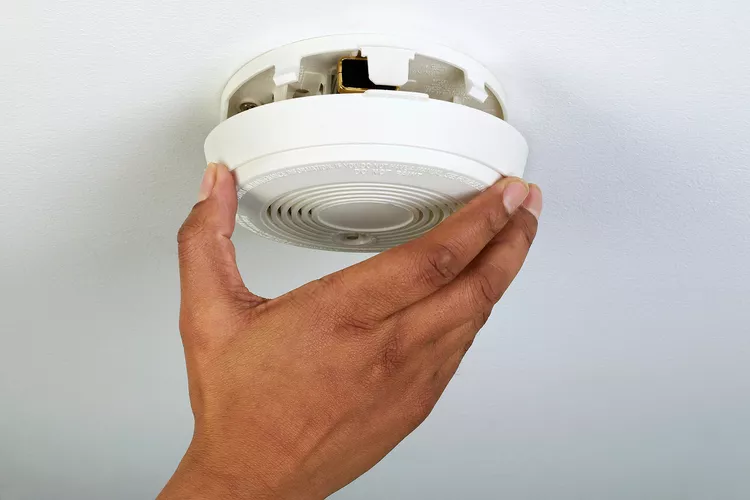How and When to Test Your Smoke Detectors

Servicing your smoke alarms is a relatively simple home maintenance task that could save your life and the roof over your head. The Consumer Product Safety Commission found that nearly two-thirds of deaths caused by house fires each year are the result of absent or faulty smoke alarms—so it’s important to make sure yours are working properly.
But how do you know if they’re working properly? We spoke with Steve Kerber, the vice president and executive director of the Fire Safety Research Institute (or, FSRI) to learn exactly how and when to test your home’s smoke alarms. He also shares helpful tips about where to install them in your home to make sure they work effectively.
Where Should Smoke Alarms Be Installed in Your Home?
The location of the smoke alarms in your home is one of the most important factors to think about when you’re considering safety. “Working smoke alarms should be installed on every floor of your home, inside each bedroom and outside every sleeping area,” Kerber says. Detectors should be placed high up, either on the ceilings or near the top of walls. If they’re going on the wall, Kerber instructs that they should be mounted no lower than one foot below where the ceiling starts and they should never be near windows, doors, or ducts. This is because a draft could impede the way they operate, making them less effective.
Additionally, Kerber advises that smoke alarms be installed a minimum of 10 feet away from any cooking appliances, such as the oven. They should also be wired so that one alarm triggers the others throughout the home. “If possible, they should be interconnected so when one sounds, they all sound,” he says.
How to Test Your Smoke Alarms
Once you’ve determined that you have enough smoke alarms and they’re installed in the correct places, it’s time to put them to the test.
This process is fairly straightforward as there’s typically a “test” button on the detectors themselves. If you press it and hear a very loud beep, Kerber says it’s in proper working form. “If the sound is weak or there isn’t a sound, it’s time to replace your batteries, or the whole device if it’s a sealed-battery alarm,” he says.
When to Test Your Smoke Alarms
Smoke alarms should be tested ideally once a month, Kerber advises, or at the very least, twice per year. He suggests using Daylight Savings Time as your key to sticking to a six-month schedule. “When you go to set your clock forward or back, also check your smoke alarms,” Kerber says.
Aside from using Daylight Savings Time, Kerber offers an alternative, yet still simple, way to remind yourself to test the smoke alarm and that’s to use your phone. “You can make a note on your phone or calendar to remind yourself to check your smoke alarms,” he says. “Another effective way to keep a record is leaving a note on your fridge to write down the date you last tested them.”
The time of year doesn’t really matter, as long as you stick to a six-month schedule (or more frequently, if you can). Really, it just depends on what works best for your household so that you make sure it gets done at least twice per year.
How Often to Replace Smoke Detectors
Kerber also explains that smoke alarms need to be replaced every few years, per the manufacturer’s instructions. “It’s usually every 10 years, or when they stop working—whichever comes first,” he says. “If your smoke alarm is more than 10 years old, install new alarms and look for products that are third-party listed or certified.”
More Home Fire Safety Tips
Kerber explains that working smoke alarms aren’t the only way to keep your family safe. He suggests implementing a fire safety practice called ‘Close Before You Doze,’ which involves closing bedroom doors before going to sleep. “According to FSRI’s research, closed doors can be an effective barrier against deadly levels of carbon monoxide, smoke, and flames,” he says. “In fact, there can be a 900-degree Fahrenheit temperature difference between a room with an open door and one with a closed door. While a room with an open door may reach 1,000 degrees Fahrenheit, a room with a closed door may only reach 100 degrees Fahrenheit.”
Even with your smoke alarms up to date and working properly, it’s still vital to have an escape route for all family members in the event of a fire. Kerber explains that in an emergency situation, you typically only have three minutes or fewer to evacuate, so there’s no time to plan in the moment. Instead, he stresses the importance of creating an escape route for your family. Kerber suggests including three options and practicing them often. He describes these as plans A, B, and C.
- Plan A is exiting through the nearest door, closing it behind you, and meeting at your prearranged family spot (such as the house across the street) to dial 911.
- Plan B is exiting through an alternate exit, like a window, attempting to close the door or window behind you, and meeting at your prearranged family spot to dial 911.
- Plan C is if you cannot get out, you must get behind a closed door as far away from the fire as possible, turn a light on, and do whatever you can to alert the fire department that you’re inside the home. Cover any cracks with clothes, towels, curtains, or anything else you have available to prevent smoke from entering the space.
